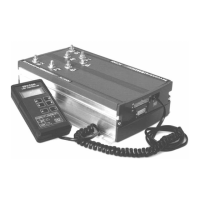Page 24 SC2000 Manual – 177/52301 Rev G 22
nd
October
2004
Bypass can be initiated in 2 ways:
Current-limit Bypass: the accelerator is fully depressed and the controller has been in current limit
for longer than 2 seconds. In order to prevent a sudden lurch of the truck the contactor will not be
energised if the motor voltage during current limit is less than 20% of battery voltage. This mode of
operation can be disabled via the setup menu.
High-speed Bypass: If the accelerator is fully depressed and the controller has been pulsing at
maximum % on for 1.5 seconds and the Bypass Delay personality has timed out. The Bypass delay
timer is a feature that can be used to allow the truck to obtain full speed, before contactor closure.
The bypass contactor will be de-energised if the accelerator demand is reduced below 86%, or if the
motor current exceeds the Bypass over-current dropout level, adjustable by the calibrator. To allow
for initial overshoots the over current test is disabled for the first 2 seconds of Bypass. Although the
software attempts to minimise arcing when the contactor opens, some arcing is inevitable under
certain load conditions. After an over-current drop out, the Bypass function will be inhibited until
neutral is recycled to prevent repeated opening and closing of the tips under heavy current
conditions.
Bypass can be disabled by setting the over-current drop out to 0 A. Also Bypass will be disabled if
either of the 2 speed cutback switches are enabled and the settings are adjusted below 95% or the
maximum speed setting is less than 95%. Applying the footbrake switch or economy > 0% will also
prevent Bypass closure.
10.1.10 Field Weakening
- This is carried out by connecting a low value/high wattage resistor
connected in series with a contactor across the traction motor field to weaken the field and hence
increase speed whilst reducing torque. As a guide line the value of the resistor should be the same
as the motor field resistance and it should be rated to carry field current.
At full accelerator depression and maximum %on, and after bypass contactor closure (if fitted) the
field weakening contactor is energised providing the current is below the Pull-In level. If the motor
current increases above the Drop-out level or the accelerator demand is less than 86% or the
bypass contactor is de-energised, the Field Weakening contactor will be opened. Both the Field
Weakening Drop-Out and Pull-In current levels are adjusted with the calibrator.
10.1.11 Power Steer
- A contactor drive is available to control a separate Power Steer motor. An
adjustable delay allows the motor to operate for a set time, after the power steer trigger or power
steer demand has been removed. SEVCON’S standard trigger, i.e. when the contactor is closed, is
when either FS1 or the Footbrake switch is closed, or the Traction unit is pulsing. It is an either-or
situation, so any one of these 3 inputs is sufficient to trigger the Power Steer.
This standard trigger is designed to give power steer when ever the truck is moving, but not to have
a situation where the Power steer could be on continuously, i.e. on a direction switch where the
truck could be left with a direction selected and the Key switch left on. If FS1 or the Footbrake is
applied then the vehicle is either about to move or is moving, and the Traction pulsing is used if the
truck was neutral braking (pulsing) down a long ramp, when it is conceivable that neither of the two
switches would be closed. On a tow-tractor, power steer is disabled during inching.
An independent input pin (connector A, pin 14) also exists to trigger Power Steer operation. This is
normally used in conjunction with a steer on demand system where an output is generated when the
steering wheel is turned. This gives Power steer on demand and is more efficient since typically no
steering delay, or only a short delay is needed.
The independent trigger only, or other trigger combinations can be configured if necessary in the
setup menu. Some vehicles derive the power steering assistance from the main Pump Hydraulic
motor, instead of having a separate Steer motor. In this situation the trigger is fed to the Pump
controller and runs the pump at the speed set by the P. S. Speed personality 2.1.19.
Independent ramp up and ramp down delays are provided when Power steer assistance is derived
from the main Pump controller, to help tune steering responsiveness without affecting the main
pump operation.

